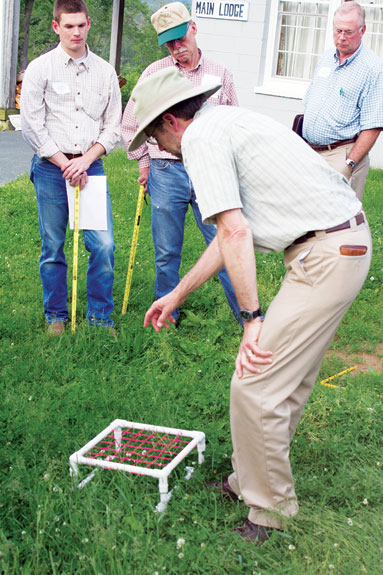Seedling grass identification? Learned about it. Plant physiology?

Examined it. Determining forage mass? Ditto.
And we might as well add these to the list: grazing and cutting height, cool-season grasses for dairy herds, grass fertility, nutrient management, orchardgrass research, pest control and forage species adaptation.
It was “plant college 101” combined with “plant finals 410,” engaging fifth-generation farmers and ranchers as well as first-year producers.
Then throw in farm tours, great company, good food, Graves Mountain Lodge, 17-year cicadas and a kaleidoscope of Virginia countryside, and you have the American Forage and Grassland Council 2013 workshop and tour recently held in Syria, Virginia.
Hosted by Virginia Cooperative Extension and Virginia Forage and Grassland Council, the first two days were filled with classroom-style presentations, discussions and demonstrations helping producers, educators and allied industry professionals understand key concepts of the importance and nature of forage and grassland resources.
Featured guest speaker Commissioner Matthew J. Lohr of Virginia Department of Agriculture and Consumer Services, noted, “The future of Virginia agriculture is very bright.
One of the reasons is that Virginia is such a diverse state in scope, products and practices.
We have large farms and small, national brands and products sold only at the farm gate.
Our products range from the traditional livestock, dairy and row crops to specialty crops, tobacco, wine, seafood, fruits and nuts, berries, lumber and nursery products.
Our practices include traditional agriculture as well as no-till and organic. A very bright aspect of Virginia agriculture is our exports. In 2012, we broke all records for exports of agricultural products, and we have seen explosive growth in new markets such as China, Morocco and Cuba.”
The Blue Ridge Mountains provided a vibrant green backdrop to the education and collaboration of forage industry researchers, producers and allied professionals.
Ninety-two attendees from 18 states packed as much exposure to forage research and various forage techniques and management tools into four days as was humanly possible.
As one attendee put it, “You’d have to be dead not to learn something here.”
Patty Johnson, Virginia Forage and Grassland Council president, stated, “I guess most people think of ham and peanuts when they think of agriculture in Virginia, but I think Virginia may look more like what the global future of farming truly looks like – we’re a microcosm of conditions faced by producers everywhere.
By producing high-quality forage, we can produce high-quality protein on smaller tracts of land with less-than-ideal terrain and with less-than-ideal soil conditions.”
Tour stops included Eldon Farm in Rappahannock County, Kenwood Farm, LLC and Virginia Tech Northern Piedmont Center in Orange County, as well as Cedar Springs Dairy, Duck Farm and a hayride to Riverbend Farm in Madison County.
Other events included an equipment demonstration, tractor safety presentation, sponsor displays, hay contest and Beef Quality Assurance certification.
Johnson noted challenges for Virginia growers included shorter drying windows, dealing with multiple landowners, urban encroachment and political scrutiny.
Johnson stated, “This gave us an opportunity to show forage producers from across the country some of the opportunities and challenges of farming in the Chesapeake Bay watershed.
We’re farming profitably in a region that’s not only environmentally and historically sensitive but also close to population centers.
And to a large degree, our proximity to the nation’s capital subjects us to both media and legislative scrutiny that most producers aren’t subjected to. Whether we like it or not, our actions influence both the public and public policy. As producers, we can either fight that reality or accept it.” FG
Did we catch you in our exclusive video footage of the AFGC 2013 tour? Click here to find out.
PHOTOS
FIRST: American Forage and Grassland Council 2013 workshop and tour recently held in Syria, Virginia.
SECOND: (shown left to right) Bill Tucker; AFGC President Chad Hale; Virginia FGC President Patty Johnson; Kristin Ulmer (winner of the White Memorial Scholarship sponsored by Virginia FGC); past AFGC President John Rogers; and Dr. Allen Grant, dean of Virginia Tech College of Agriculture and Life Sciences.
THIRD: Dr. Ray Smith, University of Kentucky forage extension specialist, demonstrates a process to determine forage density and mass.
FORTH: Tour participants watch a round bale net-wrap demonstration. Photos by Lynn Jaynes.










